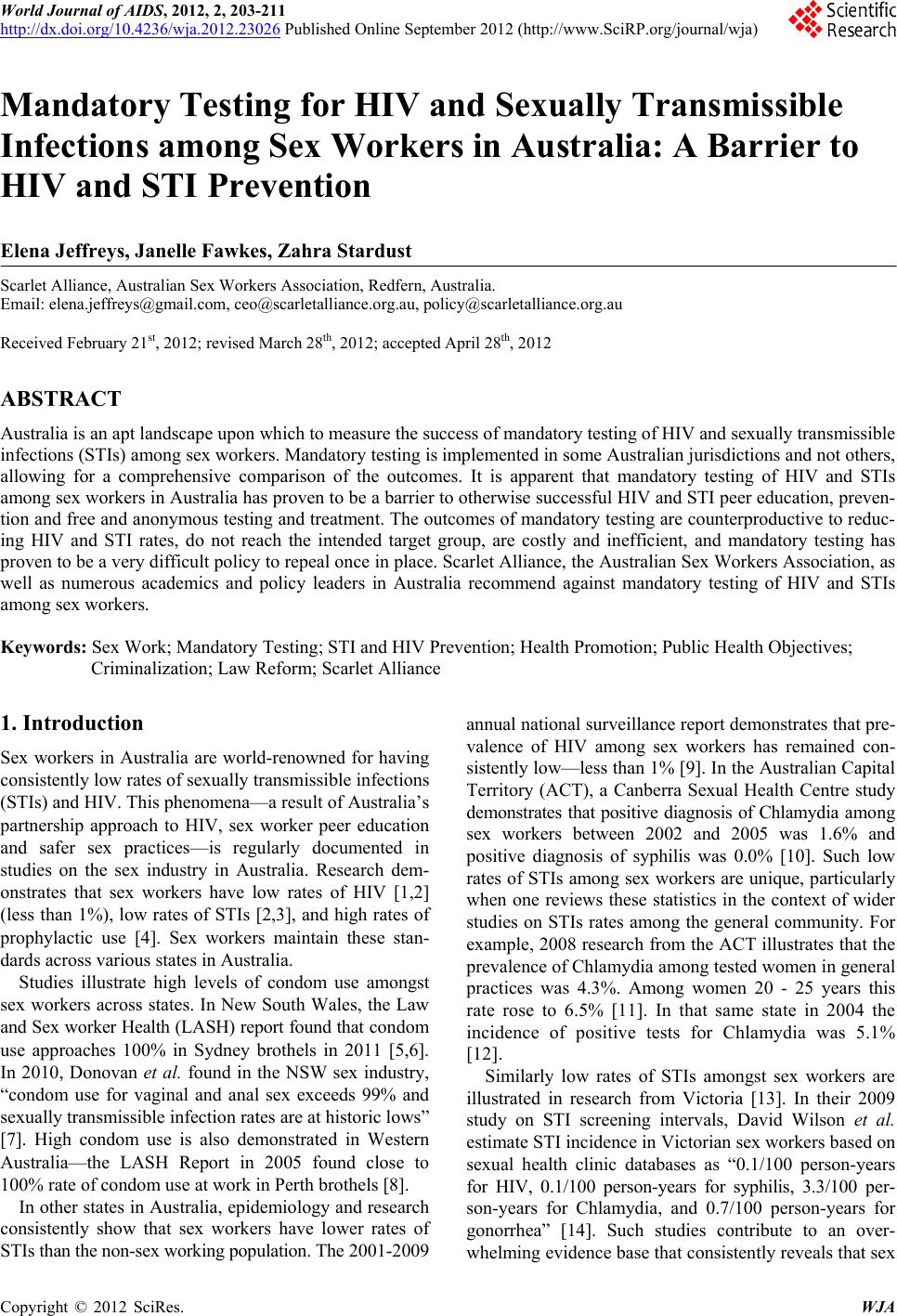 World Journal of AIDS, 2012, 2, 203-211 http://dx.doi.org/10.4236/wja.2012.23026 Published Online September 2012 (http://www.SciRP.org/journal/wja) 203 Mandatory Testing for HIV and Sexually Transmissible Infections among Sex Workers in Australia: A Barrier to HIV and STI Prevention Elena Jeffreys, Janelle Fawkes, Zahra Stardust Scarlet Alliance, Australian Sex Workers Association, Redfern, Australia. Email: elena.jeffreys@gmail.com, ceo@scarletalliance.org.au, policy@scarletalliance.org.au Received February 21st, 2012; revised March 28th, 2012; accepted April 28th, 2012 ABSTRACT Australia is an apt landscape upon which to measure the success of mandatory testing of HIV and sexually transmissible infections (STIs) among sex workers. Mandatory testing is implemented in some Australian jurisdictions and not others, allowing for a comprehensive comparison of the outcomes. It is apparent that mandatory testing of HIV and STIs among sex workers in Australia has proven to be a barrier to otherwise successful HIV and STI peer education, preven- tion and free an d anonymous testing and tr eatment. The outcomes of mandatory testing are coun terproductive to reduc- ing HIV and STI rates, do not reach the intended target group, are costly and inefficient, and mandatory testing has proven to be a very difficult policy to repeal once in place. Scarlet Alliance, the Australian Sex Workers Association , as well as numerous academics and policy leaders in Australia recommend against mandatory testing of HIV and STIs among sex workers. Keywords: Sex Work; Mandatory Testing; STI and HIV Prevention; Health Promotion; Public Health Objectives; Criminalization; Law Reform; Scarlet Alliance 1. Introduction Sex workers in Australia are world-renowned for having consistently low rates of sexually transmissible infection s (STIs) and HIV. This phenomena—a result of Australia’s partnership approach to HIV, sex worker peer education and safer sex practices—is regularly documented in studies on the sex industry in Australia. Research dem- onstrates that sex workers have low rates of HIV [1,2] (less than 1%), low rates of STIs [2,3], and high rates of prophylactic use [4]. Sex workers maintain these stan- dards across various states in Australia. Studies illustrate high levels of condom use amongst sex workers across states. In New South Wales, the Law and Sex worker Health (LASH) report found that co ndo m use approaches 100% in Sydney brothels in 2011 [5,6]. In 2010, Donovan et al. found in the NSW sex industry, “condom use for vaginal and anal sex exceeds 99% and sexually transmissible infection rates are at historic lows” [7]. High condom use is also demonstrated in Western Australia—the LASH Report in 2005 found close to 100% rate of condom use at work in Perth brothels [8]. In other states in Australia, epidemiology and research consistently show that sex workers have lower rates of STIs than the non-sex working popul at i on. The 2001-2009 annual national su rveillance rep ort demonstrates that pr e- valence of HIV among sex workers has remained con- sistently low—less than 1% [9]. In the Australian Cap ital Territory (ACT), a Canberra Sexual Health Centre study demonstrates that positive diagnosis of Chlamydia among sex workers between 2002 and 2005 was 1.6% and positive diagnosis of syphilis was 0.0% [10]. Such low rates of STIs among sex workers are unique, particularly when one reviews these statistics in the context of wider studies on STIs rates among the general community. For example, 2008 research from the ACT illu strates that the prevalence of Chlamydia among tested women in general practices was 4.3%. Among women 20 - 25 years this rate rose to 6.5% [11]. In that same state in 2004 the incidence of positive tests for Chlamydia was 5.1% [12]. Similarly low rates of STIs amongst sex workers are illustrated in research from Victoria [13]. In their 2009 study on STI screening intervals, David Wilson et al. estimate STI incidence in Victorian sex workers based on sexual health clinic databases as “0.1/100 person-years for HIV, 0.1/100 person-years for syphilis, 3.3/100 per- son-years for Chlamydia, and 0.7/100 person-years for gonorrhea” [14]. Such studies contribute to an over- whelming evidence base that consistently reveals that sex Copyright © 2012 SciRes. WJA 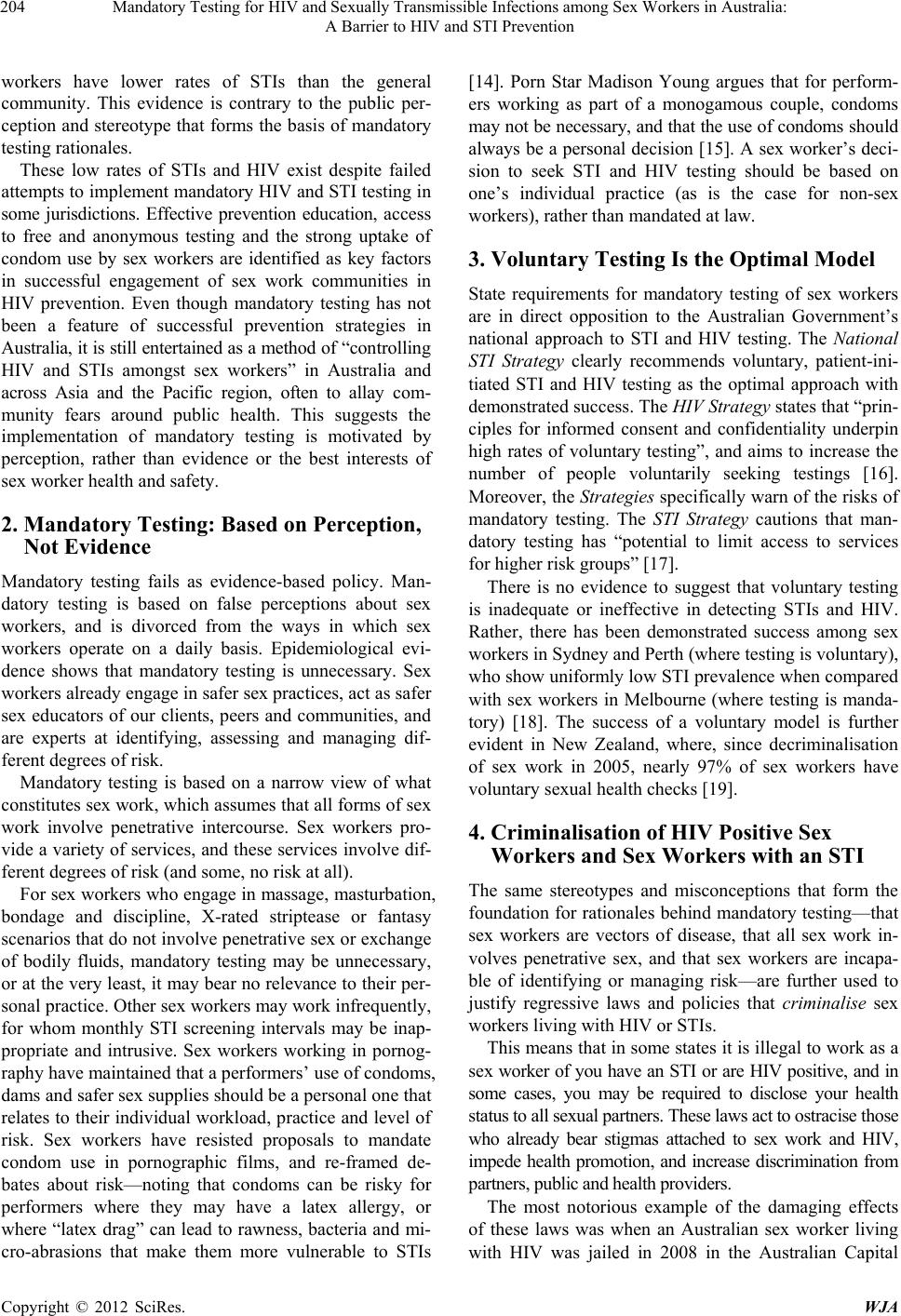 Mandatory Testing for HIV and Sexually Transmissible Infections among Sex Workers in Australia: A Barrier to HIV and STI Prevention 204 workers have lower rates of STIs than the general community. This evidence is contrary to the public per- ception and stereotype that forms the basis of mandatory testing rationales. These low rates of STIs and HIV exist despite failed attempts to implement mandatory HIV and STI testing in some jurisdictions. Effective prevention education, access to free and anonymous testing and the strong uptake of condom use by sex workers are identified as key factors in successful engagement of sex work communities in HIV prevention. Even though mandatory testing has not been a feature of successful prevention strategies in Australia, it is still entertained as a method of “controlling HIV and STIs amongst sex workers” in Australia and across Asia and the Pacific region, often to allay com- munity fears around public health. This suggests the implementation of mandatory testing is motivated by perception, rather than evidence or the best interests of sex worker health and safety. 2. Mandatory Testing: Based on Perception, Not Evidence Mandatory testing fails as evidence-based policy. Man- datory testing is based on false perceptions about sex workers, and is divorced from the ways in which sex workers operate on a daily basis. Epidemiological evi- dence shows that mandatory testing is unnecessary. Sex workers already engage in safer sex practices, act as safer sex educators of our clients, peers and communities, and are experts at identifying, assessing and managing dif- ferent degrees of risk. Mandatory testing is based on a narrow view of what constitutes sex work, wh ich assumes that all forms of sex work involve penetrative intercourse. Sex workers pro- vide a variety of services, and these services involve dif- ferent degrees of risk (and some, no risk at all). For sex workers who engage in massage, masturbation, bondage and discipline, X-rated striptease or fantasy scenarios that do not involve penetrative sex or exchange of bodily fluids, mandatory testing may be unnecessary, or at the very least, it may bear no relevance to their per- sonal practice. Other sex workers may work infrequently, for whom monthly STI screening intervals may be inap- propriate and intrusive. Sex workers working in pornog- raphy have maintain ed that a perf ormers’ use of co ndoms, dams and safer sex supplies should be a personal one that relates to their individual workload, practice and level of risk. Sex workers have resisted proposals to mandate condom use in pornographic films, and re-framed de- bates about risk—noting that condoms can be risky for performers where they may have a latex allergy, or where “latex drag” can lead to rawness, bacteria and mi- cro-abrasions that make them more vulnerable to STIs [14]. Porn Star Madison Young argues that for perform- ers working as part of a monogamous couple, condoms may not be necessary, and that the use of condoms should always be a personal decision [15]. A sex worker’s deci- sion to seek STI and HIV testing should be based on one’s individual practice (as is the case for non-sex workers), rather than mandated at law. 3. Voluntary Testing Is the Optimal Model State requirements for mandatory testing of sex workers are in direct opposition to the Australian Government’s national approach to STI and HIV testing. The National STI Strategy clearly recommends voluntary, patient-ini- tiated STI and HIV testing as the optimal approach with demonstrated success. The HIV Strategy states that “prin- ciples for informed consent and confidentiality underpin high rates of voluntary testing”, and aims to increase the number of people voluntarily seeking testings [16]. Moreover, the Strategies sp ecifically warn of the risks of mandatory testing. The STI Strategy cautions that man- datory testing has “potential to limit access to services for higher ris k gr o ups” [17]. There is no evidence to suggest that voluntary testing is inadequate or ineffective in detecting STIs and HIV. Rather, there has been demonstrated success among sex workers in Sydney and Perth (where testing is voluntary), who show uniformly low STI pr evalen ce when co mpared with sex workers in Melbourne (where testing is manda- tory) [18]. The success of a voluntary model is further evident in New Zealand, where, since decriminalisation of sex work in 2005, nearly 97% of sex workers have voluntary sexual health checks [19]. 4. Criminalisation of HIV Positive Sex Workers and Sex Workers with an STI The same stereotypes and misconceptions that form the foundation for rationales behind mandatory testing—that sex workers are vectors of disease, that all sex work in- volves penetrative sex, and that sex workers are incapa- ble of identifying or managing risk—are further used to justify regressive laws and policies that criminalise sex workers living with HIV or STIs. This means that in some states it is illegal to work as a se x worker of you have an STI or are HIV positive, and in some cases, you may be required to disclose your health status to all sexual pa rtne rs. These laws act to ostracise t hose who already bear stigmas attached to sex work and HIV, impede health promotion, and increase discrimination from partners, public and health providers. The most notorious example of the damaging effects of these laws was when an Australian sex worker living with HIV was jailed in 2008 in the Australian Capital Copyright © 2012 SciRes. WJA  Mandatory Testing for HIV and Sexually Transmissible Infections among Sex Workers in Australia: A Barrier to HIV and STI Prevention 205 Territory. Despite no evidence of transmission of HIV or unsafe sex practice, the person was prosecuted for pro- viding a sexual service whilst knowingly HIV positive. As a contact-chasing strategy, and against the advice of Scarlet Alliance, the Chief Public Health Officer released the person’s name, HIV status and unrelated personal details to the media [20]. The person was outed, stigma- tised and vilified in articles appearing across Australia, New Zealand, Germany, Vietnam, Belgium and Hong Kong [21]. Elena Jeffreys, Kane Matthews and Alina Thomas write in their article on HIV criminalisation and sex work that as a result of this case, “many sex workers became fearful of testing for HIV” leading to a dramatic drop in sex worker attendance at outreach medical ser- vices. They report: “In the four-week period following the court case, the numbers attending the service dropped from an average of 40 per night to three” [21]. Ally Daniel writes that the effect of criminalisation is then to decrease testing, decrease detection, and therefore poten- tially increase transmission rates overall [21]. The criminalization of sex workers working with HIV or STIs is unnecessary and contrary to public health ob- jectives. State criminal laws are contrary to the National Guidelines for the Management of People with HIV Who Place Others at Risk, which recognize the human rights of people living with HIV, assume equal responsibility for HIV prevention among all people, and recommend counselling and sup port over detention or police referral. Moreover, these state criminal laws are largely divorced from the ways in which people—including and especially HIV positive sex workers—practice safer sex. Research from the Australian Federation of AIDS Organisations reveals that men who have sex with men already under- take a range of non-condom based HIV risk reduction strategies, including strategic positioning (the use of se- rostatus to determine sexual roles during sex), serosort- ing (the restriction of unprotected sex to partners of con- cordant HIV status), and undetectable viral load (the use of viral load test results to assess the risk of HIV among non-condordant partners) [22]. These strategies indicate that people living with HIV are aware and conscious of negotiating, identifying and managing risks—by catering solely to HIV positive clients, utilisin g safer sex practices, or negotiating HIV risk reduction strategies. Janelle Fawkes writes elsewhere: The high number of sero-discordant relationships in which the HIV negative partner does not acquire HIV demonstrates that protected sex with an HIV-positive person does not necessarily lead to transmission... The high levels of condom use amongst Australian sex work- ers means there is no need to exclude HIV positive peo- ple from sex work [23] . 5. Mandatory Testing: A Policy Failure Mandatory testing in Australia endorses a false sense of security in the form of a “certificate”, which, due to window periods, doesn’t actually confirm a sex worker’s sexual health status, but instead just indicates that the sex worker has participated with the states’ mandatory test- ing regime. As a result, compliance with the regime has no measurable impact on the health of sex workers who are not experiencing STI symptoms, and has a negative impact on those who are. The sexual health services are overloaded by a regime that must produce certificates for every sex worker, regardless of whether they are experi- encing symptoms or not. As concluded by Donovan and Harcourt, sex workers who experienced a condom brea- kage and need to access sexual health services quickly are particularly marginalised by mandatory testing [24]. Mandatory testing has a negative impact on the general delivery of sexual health services to sex workers. Mandatory testing also has had negative consequences for sex worker confidentiality, human rights and indu str ia l rights in Australia. In some instances, sex workers report brothel operators requiring them to see a doctor of the operator’s choice, following which the results are handed directly back to the operator rather than the worker, without regard for that worker’s privacy. Although it may be legal to work, it may be difficult to obtain work without a health certificate, thus mandatory testing be- comes imbedded within industrial relations practises. In these situations “voluntary” testing is not voluntary in practice. In some countries, sex workers report sexual health clinic staff arriving spontaneously at a sex work workplace to conduct blood tests on the premises. This was witnessed by Scarlet Alliance migration project staff while on outreach in Thailand. Those sex workers who declined testing were treated with suspicion. An NGO Delegate (Asia and the Pacific) to the 2011 UN AIDS Program Coordinating Board writes that HIV programming for sex workers is often imple mented at the expense of sex worker human rights: When there is HIV programming for sex workers, it is often fraught with human rights violations. In trying to meet donor indicators, national voluntary counselling and testing (VCT) targets often lead to programmes that force sex workers into unnecessary HIV and STI tests, as evidenced in Laos, Thailand and India. Results are often shared with brothel owners, outreach workers and NGOs. Pre- and post-test coun selling do not inform sex workers of their right to refuse tests. In some countries, the police or the army are also used to enforce testin g and to Reg is- ter sex workers [25]. In these instances mandatory testing, though not legis- lated in developing coun tries in the way it is in Australia, is implemented arbitrarily by police and other powerful Copyright © 2012 SciRes. WJA 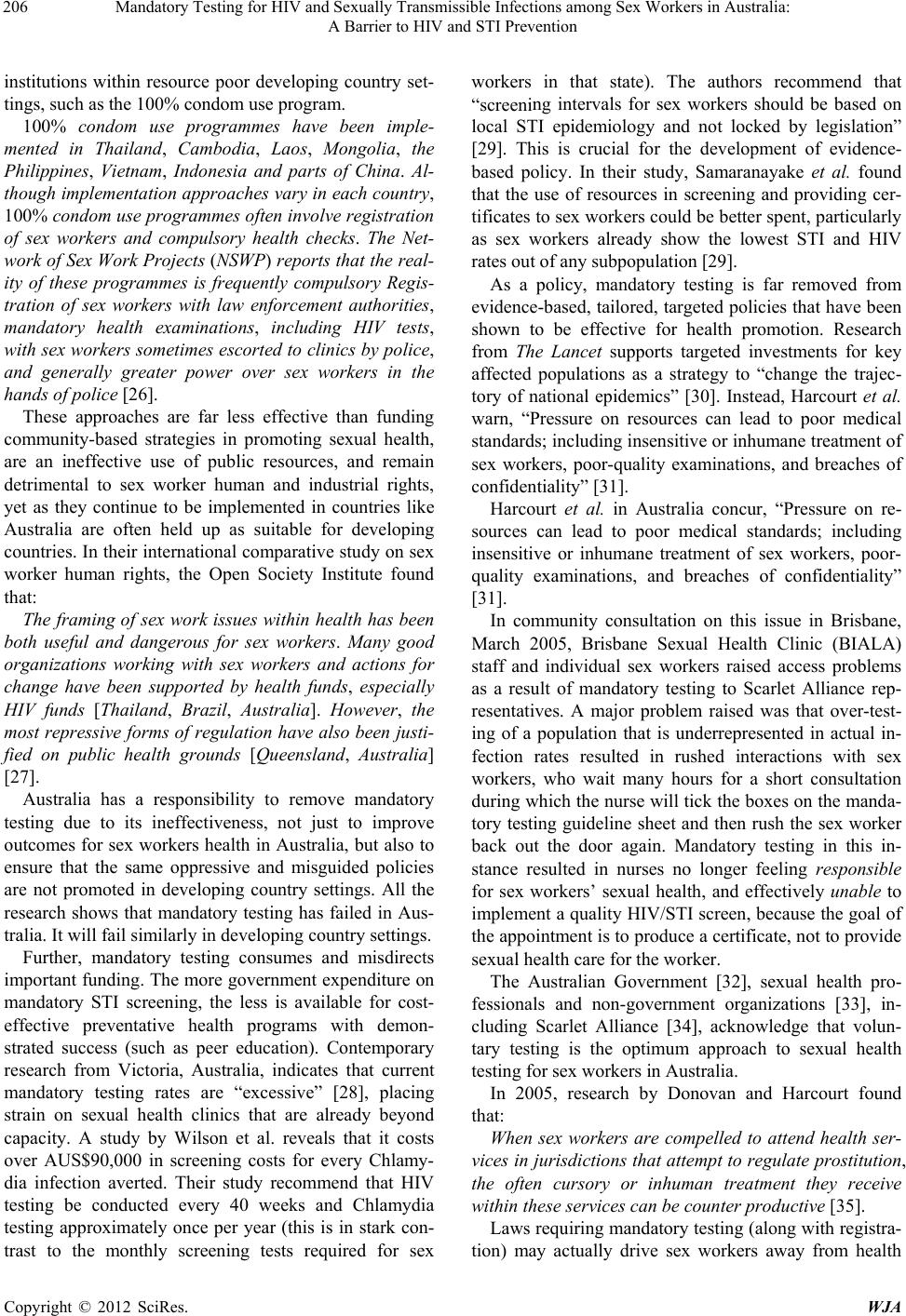 Mandatory Testing for HIV and Sexually Transmissible Infections among Sex Workers in Australia: A Barrier to HIV and STI Prevention 206 institutions within resource poor developing country set- tings, such as the 100% condo m use program. 100% condom use programmes have been imple- mented in Thailand, Cambodia, Laos, Mongolia, the Philippines, Vietnam, Indonesia and parts of China. Al- though implementa tion approaches vary in each country , 100% condom use programmes often involve reg istration of sex workers and compulsory health checks. The Net- work of Sex Work Projects (NSWP) reports that the real- ity of these programmes is frequently compulsory Regis- tration of sex workers with law enforcement authorities, mandatory health examinations, including HIV tests, with sex workers sometimes escorted to clinics by police, and generally greater power over sex workers in the hands of polic e [26]. These approaches are far less effective than funding community-based strategies in promoting sexual health, are an ineffective use of public resources, and remain detrimental to sex worker human and industrial rights, yet as they continue to be implemented in countries like Australia are often held up as suitable for developing countries. In their international comparative study on sex worker human rights, the Open Society Institute found that: The framing of sex work issues within health ha s been both useful and dangerous for sex workers. Many good organizations working with sex workers and actions for change have been supported by health funds, especially HIV funds [Thailand, Brazil, Australia]. However, the most repressive forms of regulation have also been justi- fied on public health grounds [Queensland, Australia] [27]. Australia has a responsibility to remove mandatory testing due to its ineffectiveness, not just to improve outcomes for sex workers health in Australia, but also to ensure that the same oppressive and misguided policies are not promoted in developing country settings. All the research shows that mandatory testing has failed in Aus- tralia. It will fail similarly in developing country setting s . Further, mandatory testing consumes and misdirects important funding. The more government expenditure on mandatory STI screening, the less is available for cost- effective preventative health programs with demon- strated success (such as peer education). Contemporary research from Victoria, Australia, indicates that current mandatory testing rates are “excessive” [28], placing strain on sexual health clinics that are already beyond capacity. A study by Wilson et al. reveals that it costs over AUS$90,000 in screening costs for every Chlamy- dia infection averted. Their study recommend that HIV testing be conducted every 40 weeks and Chlamydia testing approximately once per year (this is in stark con- trast to the monthly screening tests required for sex workers in that state). The authors recommend that “screening intervals for sex workers should be based on local STI epidemiology and not locked by legislation” [29]. This is crucial for the development of evidence- based policy. In their study, Samaranayake et al. found that the use of resources in screening and providing cer- tificates to sex workers could be better spen t, particularly as sex workers already show the lowest STI and HIV rates out of any subpopulation [29]. As a policy, mandatory testing is far removed from evidence-based , tailored, targeted policies that hav e been shown to be effective for health promotion. Research from The Lancet supports targeted investments for key affected populations as a strategy to “change the trajec- tory of national epidemics” [30]. Instead, Harcourt et al. warn, “Pressure on resources can lead to poor medical standards; including insensitiv e or inhumane treatment of sex workers, poor-quality examinations, and breaches of confidentiality” [3 1]. Harcourt et al. in Australia concur, “Pressure on re- sources can lead to poor medical standards; including insensitive or inhumane treatment of sex workers, poor- quality examinations, and breaches of confidentiality” [31]. In community consultation on this issue in Brisbane, March 2005, Brisbane Sexual Health Clinic (BIALA) staff and individual sex workers raised access problems as a result of mandatory testing to Scarlet Alliance rep- resentatives. A major problem raised was that over-test- ing of a population that is underrepresented in actual in- fection rates resulted in rushed interactions with sex workers, who wait many hours for a short consultation during which the nu rse will tick the boxes on the manda- tory testing guideline sheet and then rush the sex worker back out the door again. Mandatory testing in this in- stance resulted in nurses no longer feeling responsible for sex workers’ sexual health, and effectively unable to implement a quality HIV/STI screen, because the goal of the appointment is to pro duce a certificate, not to provide sexual health care for the worker. The Australian Government [32], sexual health pro- fessionals and non-government organizations [33], in- cluding Scarlet Alliance [34], acknowledge that volun- tary testing is the optimum approach to sexual health testing for sex workers in Australia. In 2005, research by Donovan and Harcourt found that: When sex workers are compelled to attend health ser- vices in jurisdictions that attemp t to regulate prostitution, the often cursory or inhuman treatment they receive within these services can be co unter productive [35]. Laws requiring mandatory testing (along with registra- tion) may actually drive sex workers away from health Copyright © 2012 SciRes. WJA 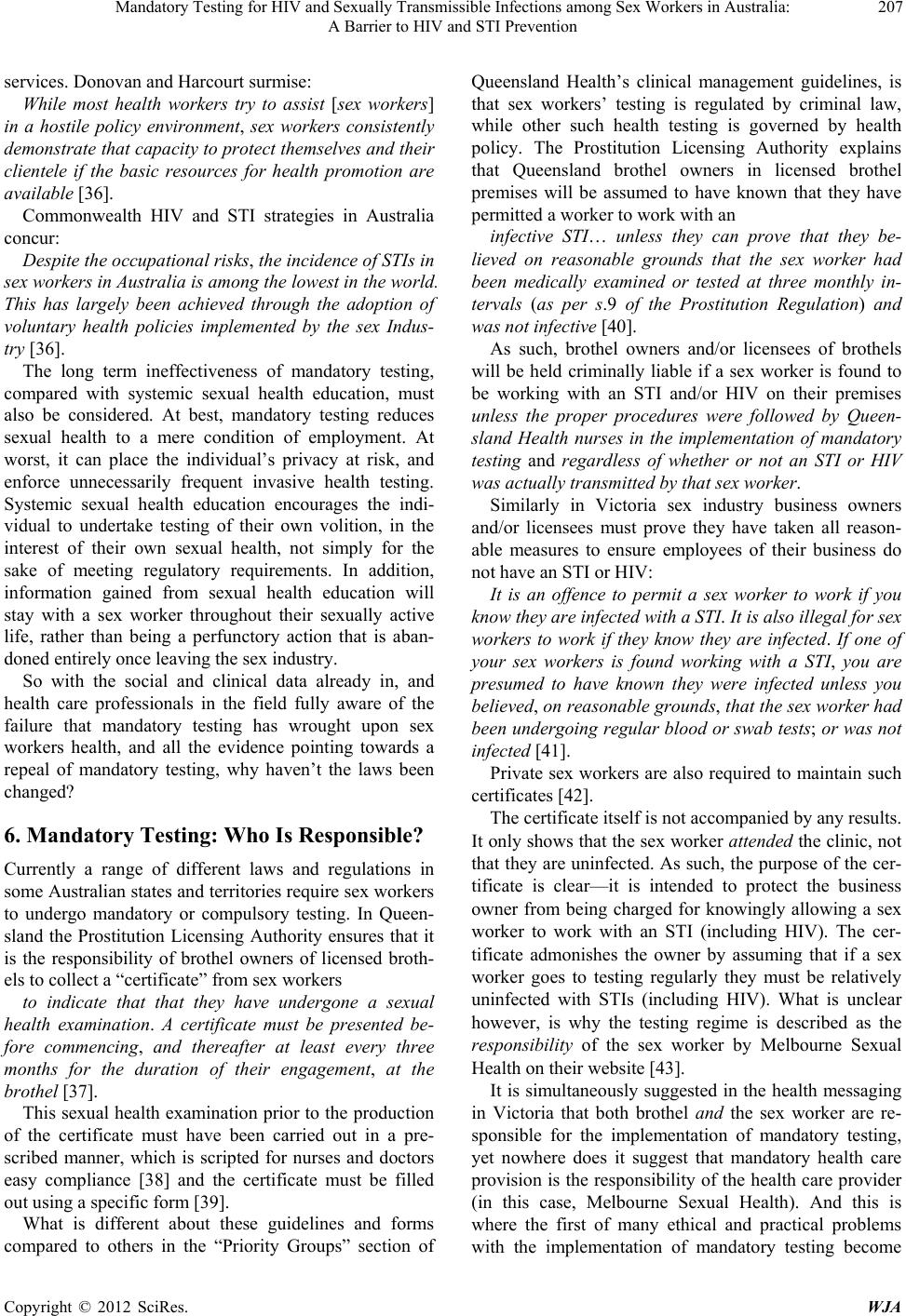 Mandatory Testing for HIV and Sexually Transmissible Infections among Sex Workers in Australia: A Barrier to HIV and STI Prevention 207 services. Donovan and Harcourt surmise: While most health workers try to assist [sex workers] in a hostile policy environment, sex workers consistently demonstrate that capacity to protect themselves and their clientele if the basic resources for health promotion are available [36]. Commonwealth HIV and STI strategies in Australia concur: Despite the occupational risks, the incidence of STIs in sex workers in Australia is among the lowest in the world. This has largely been achieved through the adoption of voluntary health policies implemented by the sex Indus- try [36]. The long term ineffectiveness of mandatory testing, compared with systemic sexual health education, must also be considered. At best, mandatory testing reduces sexual health to a mere condition of employment. At worst, it can place the individual’s privacy at risk, and enforce unnecessarily frequent invasive health testing. Systemic sexual health education encourages the indi- vidual to undertake testing of their own volition, in the interest of their own sexual health, not simply for the sake of meeting regulatory requirements. In addition, information gained from sexual health education will stay with a sex worker throughout their sexually active life, rather than being a perfunctory action that is aban- doned entirely once leaving the sex industry. So with the social and clinical data already in, and health care professionals in the field fully aware of the failure that mandatory testing has wrought upon sex workers health, and all the evidence pointing towards a repeal of mandatory testing, why haven’t the laws been changed? 6. Mandatory Testing: Who Is Responsible? Currently a range of different laws and regulations in some Australian states and territories require sex workers to undergo mandatory or compulsory testing. In Queen- sland the Prostitution Licensing Authority ensures that it is the responsibility of brothel owners of licensed broth- els to collect a “certificate” from sex workers to indicate that that they have undergone a sexual health examination. A certificate must be presented be- fore commencing, and thereafter at least every three months for the duration of their engagement, at the brothel [37]. This sexual health examinatio n prior to the production of the certificate must have been carried out in a pre- scribed manner, which is scripted for nurses and doctors easy compliance [38] and the certificate must be filled out using a specific form [39]. What is different about these guidelines and forms compared to others in the “Priority Groups” section of Queensland Health’s clinical management guidelines, is that sex workers’ testing is regulated by criminal law, while other such health testing is governed by health policy. The Prostitution Licensing Authority explains that Queensland brothel owners in licensed brothel premises will be assumed to have known that they have permitted a worker to work with an infective STI… unless they can prove that they be- lieved on reasonable grounds that the sex worker had been medically examined or tested at three monthly in- tervals (as per s.9 of the Prostitution Regulation) and was not infective [40]. As such, brothel owners and/or licensees of brothels will be held criminally liable if a sex worker is found to be working with an STI and/or HIV on their premises unless the proper procedures were followed by Queen- sland Health nurses in the implementation of mandatory testing and regardless of whether or not an STI or HIV was actually transmitted by that sex worker. Similarly in Victoria sex industry business owners and/or licensees must prove they have taken all reason- able measures to ensure employees of their business do not have an ST I or HIV: It is an offence to permit a sex worker to work if you know they are infected with a STI. It is also illegal for sex workers to work if they know they are infected. If one of your sex workers is found working with a STI, you are presumed to have known they were infected unless you believed, on reasonable grounds, that the sex worker had been undergoing regular blood or swab tests; or was not infected [41]. Private sex workers are also required to maintain such certificates [42]. The certificate itself is not accompanied by any results. It only sho ws that the sex work er attended the clinic, not that they are uninfected. As such, the purpose of the cer- tificate is clear—it is intended to protect the business owner from being charged for knowingly allowing a sex worker to work with an STI (including HIV). The cer- tificate admonishes the owner by assuming that if a sex worker goes to testing regularly they must be relatively uninfected with STIs (including HIV). What is unclear however, is why the testing regime is described as the responsibility of the sex worker by Melbourne Sexual Health on their website [43 ]. It is simultaneously suggested in the health messaging in Victoria that both brothel and the sex worker are re- sponsible for the implementation of mandatory testing, yet nowhere does it suggest that mandatory health care provision is the responsibility of the health care provider (in this case, Melbourne Sexual Health). And this is where the first of many ethical and practical problems with the implementation of mandatory testing become Copyright © 2012 SciRes. WJA 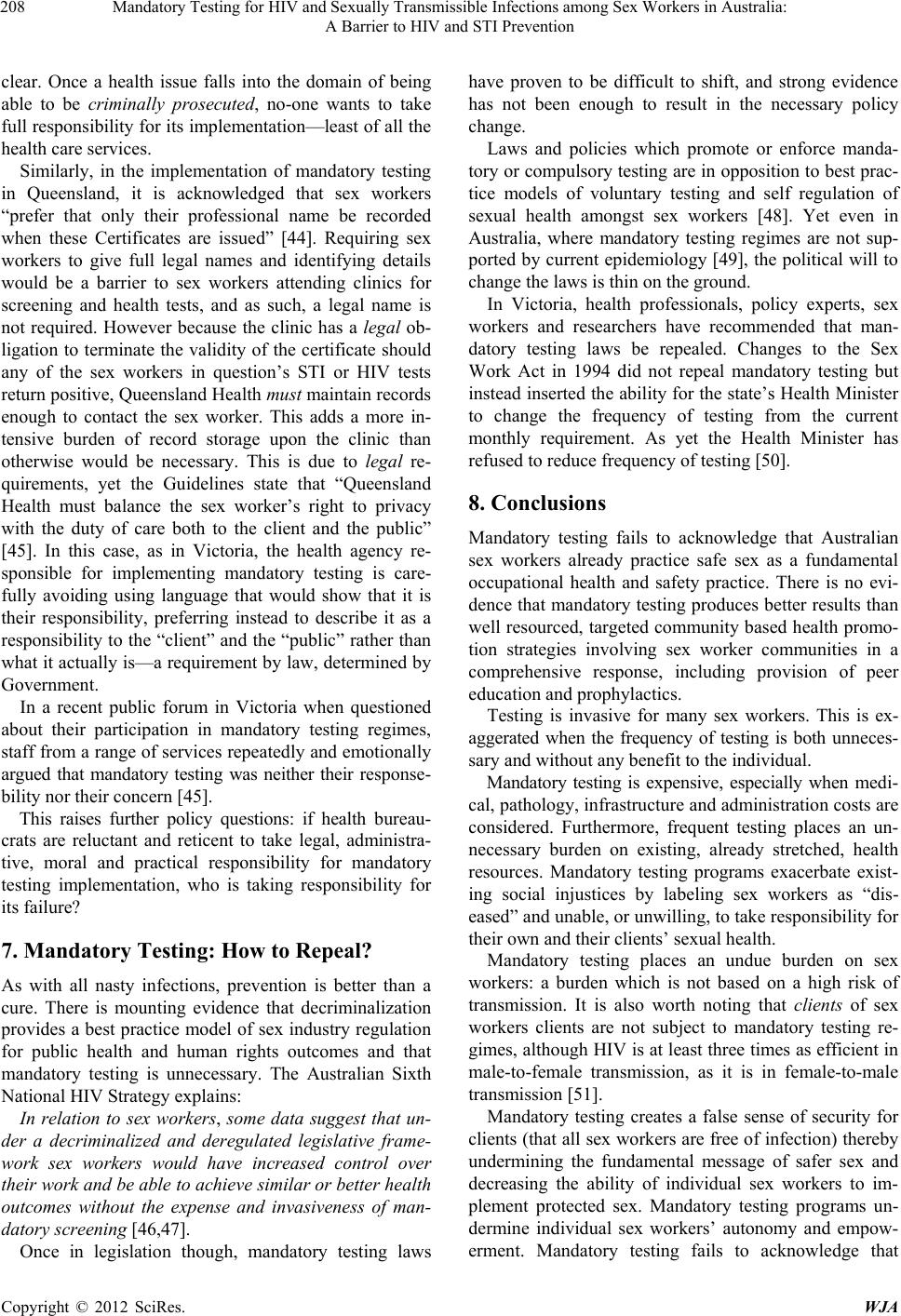 Mandatory Testing for HIV and Sexually Transmissible Infections among Sex Workers in Australia: A Barrier to HIV and STI Prevention 208 clear. Once a health issue falls into the domain of being able to be criminally prosecuted, no-one wants to take full responsibility for its implementation—least of all the health care services. Similarly, in the implementation of mandatory testing in Queensland, it is acknowledged that sex workers “prefer that only their professional name be recorded when these Certificates are issued” [44]. Requiring sex workers to give full legal names and identifying details would be a barrier to sex workers attending clinics for screening and health tests, and as such, a legal name is not required. However because the clinic has a legal ob- ligation to terminate the validity of the certificate should any of the sex workers in question’s STI or HIV tests return positive, Queensland Health must maintain records enough to contact the sex worker. This adds a more in- tensive burden of record storage upon the clinic than otherwise would be necessary. This is due to legal re- quirements, yet the Guidelines state that “Queensland Health must balance the sex worker’s right to privacy with the duty of care both to the client and the public” [45]. In this case, as in Victoria, the health agency re- sponsible for implementing mandatory testing is care- fully avoiding using language that would show that it is their responsibility, preferring instead to describe it as a responsibility to the “client” and the “public” rather than what it actually is—a requirement by law, determined by Government. In a recent public forum in Victoria when questioned about their participation in mandatory testing regimes, staff from a range of services repeatedly and emotionally argued that mandatory testing was neither their response- bility nor their concern [45]. This raises further policy questions: if health bureau- crats are reluctant and reticent to take legal, administra- tive, moral and practical responsibility for mandatory testing implementation, who is taking responsibility for its failure? 7. Mandatory Testing: How to Repeal? As with all nasty infections, prevention is better than a cure. There is mounting evidence that decriminalization provides a best practice model of sex industry regulation for public health and human rights outcomes and that mandatory testing is unnecessary. The Australian Sixth National HIV St rat egy e xpl ains: In relation to sex workers, some data suggest that un- der a decriminalized and deregulated legislative frame- work sex workers would have increased control over their work and be able to achieve similar or better health outcomes without the expense and invasiveness of man- datory screening [46,47]. Once in legislation though, mandatory testing laws have proven to be difficult to shift, and strong evidence has not been enough to result in the necessary policy change. Laws and policies which promote or enforce manda- tory or compulsory testing are in o pposition to best prac- tice models of voluntary testing and self regulation of sexual health amongst sex workers [48]. Yet even in Australia, where mandatory testing regimes are not sup- ported by current epidemiology [49], the political will to change the laws is thin on the ground. In Victoria, health professionals, policy experts, sex workers and researchers have recommended that man- datory testing laws be repealed. Changes to the Sex Work Act in 1994 did not repeal mandatory testing but instead inserted the ability for the state’s Health Min ister to change the frequency of testing from the current monthly requirement. As yet the Health Minister has refused to reduce frequency of testing [50]. 8. Conclusions Mandatory testing fails to acknowledge that Australian sex workers already practice safe sex as a fundamental occupational health and safety practice. There is no evi- dence that mandatory testing produces better results than well resourced, targeted community based health promo- tion strategies involving sex worker communities in a comprehensive response, including provision of peer education and pro phy l act i c s. Testing is invasive for many sex workers. This is ex- aggerated when the frequency of testing is both unneces- sary and without any benefit to the individual. Mandatory testing is expensive, especially when medi- cal, pathology, infrastructure and administration costs are considered. Furthermore, frequent testing places an un- necessary burden on existing, already stretched, health resources. Mandatory testing programs exacerbate exist- ing social injustices by labeling sex workers as “dis- eased” and unable, or unwillin g, to take responsibility fo r their own and their clients’ sexual health. Mandatory testing places an undue burden on sex workers: a burden which is not based on a high risk of transmission. It is also worth noting that clients of sex workers clients are not subject to mandatory testing re- gimes, although HIV is at least three times as efficient in male-to-female transmission, as it is in female-to-male transmission [51]. Mandatory testing creates a false sense of security for clients (that all sex workers are free of infection) thereby undermining the fundamental message of safer sex and decreasing the ability of individual sex workers to im- plement protected sex. Mandatory testing programs un- dermine individual sex workers’ autonomy and empow- erment. Mandatory testing fails to acknowledge that Copyright © 2012 SciRes. WJA 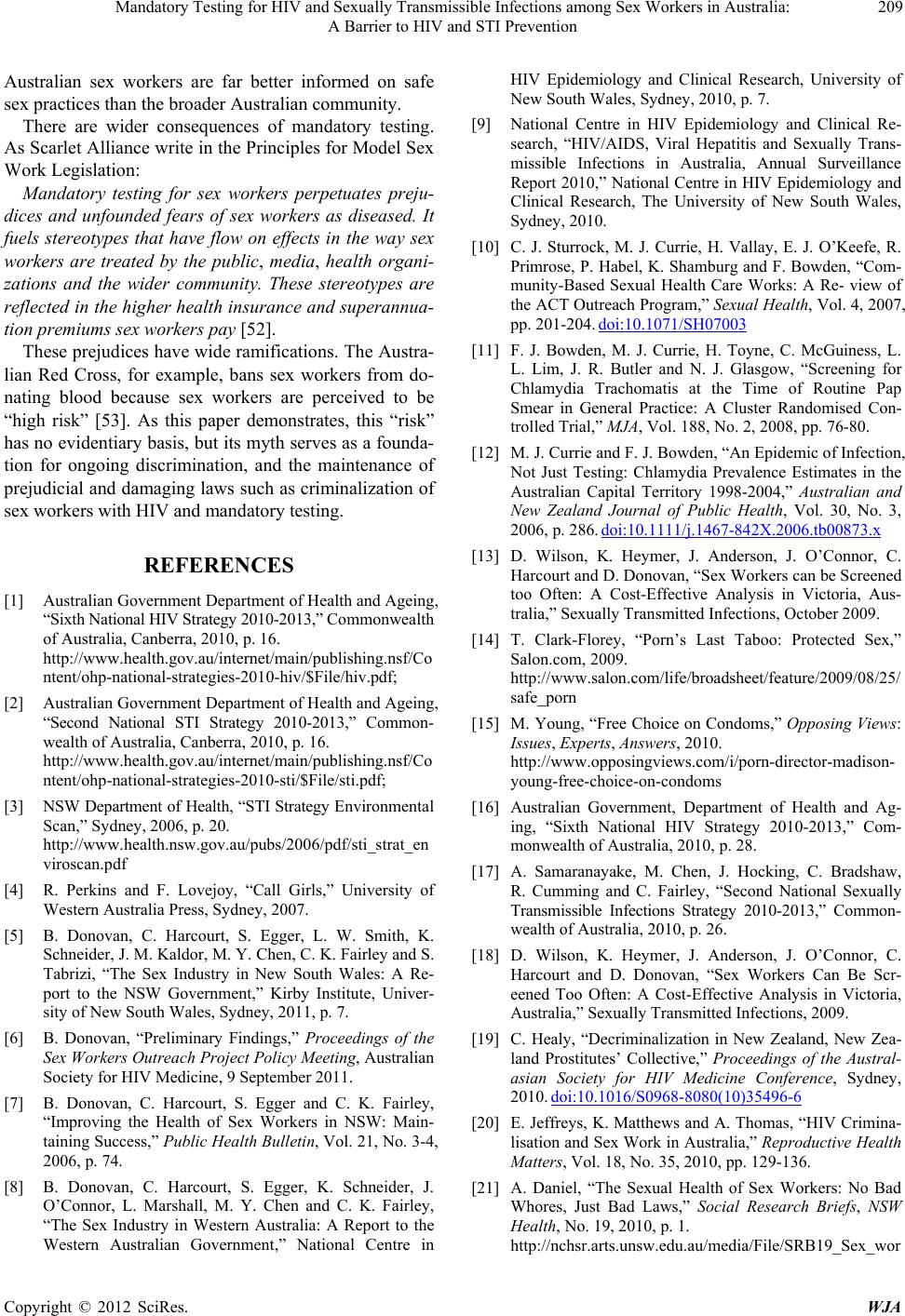 Mandatory Testing for HIV and Sexually Transmissible Infections among Sex Workers in Australia: A Barrier to HIV and STI Prevention 209 Australian sex workers are far better informed on safe sex practices than the broader Australian community. There are wider consequences of mandatory testing. As Scarlet Alliance write in the Principles for Model Sex Work Legislation: Mandatory testing for sex workers perpetuates preju- dices and unfounded fears of sex workers as diseased. It fuels stereotypes that have flow on effects in the way sex workers are treated by the public, media, health organi- zations and the wider community. These stereotypes are reflected in the higher health insuran ce and superannua- tion premiums sex workers pay [52]. These prejudices have wide ramifications. The Austra- lian Red Cross, for example, bans sex workers from do- nating blood because sex workers are perceived to be “high risk” [53]. As this paper demonstrates, this “risk” has no evidentiary b asis, but its myth serves as a founda- tion for ongoing discrimination, and the maintenance of prejudicial and damaging laws such as criminalization of sex workers with HIV and mandatory testing. REFERENCES [1] Australian Government Department of Health and Ageing, “Sixth National HIV Strategy 2010-2013,” Commonwealth of Australia, Canberra, 2010, p. 16. http://www.health.gov.au/internet/main/publishing.nsf/Co ntent/ohp-national-strategies-2010-hiv/$File/hiv.pdf; [2] Australian Government Department of Health and Ageing, “Second National STI Strategy 2010-2013,” Common- wealth of Australia, Canberra, 2010, p. 16. http://www.health.gov.au/internet/main/publishing.nsf/Co ntent/ohp-national-strategies-2010-sti/$File/sti.pdf; [3] NSW Department of Healt h, “STI Strategy Env iron ment al Scan,” Sydney, 2006, p. 20. http://www.health.nsw.gov.au/pubs/2006/pdf/sti_strat_en viroscan.pdf [4] R. Perkins and F. Lovejoy, “Call Girls,” University of Western Australia Press, Sydney, 2007. [5] B. Donovan, C. Harcourt, S. Egger, L. W. Smith, K. Schneider, J. M. Kaldor, M. Y. Chen, C. K. Fairley and S. Tabrizi, “The Sex Industry in New South Wales: A Re- port to the NSW Government,” Kirby Institute, Univer- sity of New South Wales, Sydney, 2011, p. 7. [6] B. Donovan, “Preliminary Findings,” Proceedings of the Sex Workers Outreach Project Policy Meeting, Australian Society for HIV Medicine, 9 September 2011. [7] B. Donovan, C. Harcourt, S. Egger and C. K. Fairley, “Improving the Health of Sex Workers in NSW: Main- taining Success,” Public Health Bulletin, Vol. 21, No. 3-4, 2006, p. 74. [8] B. Donovan, C. Harcourt, S. Egger, K. Schneider, J. O’Connor, L. Marshall, M. Y. Chen and C. K. Fairley, “The Sex Industry in Western Australia: A Report to the Western Australian Government,” National Centre in HIV Epidemiology and Clinical Research, University of New South Wales, Sydney, 2010, p. 7. [9] National Centre in HIV Epidemiology and Clinical Re- search, “HIV/AIDS, Viral Hepatitis and Sexually Trans- missible Infections in Australia, Annual Surveillance Report 2010,” National Centre in HIV Epidemiology and Clinical Research, The University of New South Wales, Sydney, 2010. [10] C. J. Sturrock, M. J. Currie, H. Vallay, E. J. O’Keefe, R. Primrose, P. Habel, K. Shamburg and F. Bowden, “Com- munity-Based Sexual Health Care Works: A Re- view of the ACT Outreach Program,” Sexual Health, Vol. 4, 2007, pp. 201-204. doi:10.1071/SH07003 [11] F. J. Bowden, M. J. Currie, H. Toyne, C. McGuiness, L. L. Lim, J. R. Butler and N. J. Glasgow, “Screening for Chlamydia Trachomatis at the Time of Routine Pap Smear in General Practice: A Cluster Randomised Con- trolled Trial,” MJA, Vol. 188, No. 2, 2008, pp. 76-80. [12] M. J. Currie and F. J. Bowden, “An Epidemic of Infection, Not Just Testing: Chlamydia Prevalence Estimates in the Australian Capital Territory 1998-2004,” Australian and New Zealand Journal of Public Health, Vol. 30, No. 3, 2006, p. 286. doi:10.1111/j.1467-842X.2006.tb00873.x [13] D. Wilson, K. Heymer, J. Anderson, J. O’Connor, C. Harcourt and D. Donovan, “Sex Workers can be Screened too Often: A Cost-Effective Analysis in Victoria, Aus- tralia,” Sexually Transmitted Infections, October 2009. [14] T. Clark-Florey, “Porn’s Last Taboo: Protected Sex,” Salon.com, 2009. http://www.salon.com/life/broadsheet/feature/2009/08/25/ safe_porn [15] M. Young, “Free Choice on Condoms,” Opposing Views: Issues, Experts, Answers, 2010. http://www.opposingviews.com/i/porn-director-madison- young-free-choice-on-condoms [16] Australian Government, Department of Health and Ag- ing, “Sixth National HIV Strategy 2010-2013,” Com- monwealth of Australia, 2010, p. 28. [17] A. Samaranayake, M. Chen, J. Hocking, C. Bradshaw, R. Cumming and C. Fairley, “Second National Sexually Transmissible Infections Strategy 2010-2013,” Common- wealth of Australia, 2010, p. 26. [18] D. Wilson, K. Heymer, J. Anderson, J. O’Connor, C. Harcourt and D. Donovan, “Sex Workers Can Be Scr- eened Too Often: A Cost-Effective Analysis in Victoria, Australia,” Sexually Transmitted Infections, 2009. [19] C. Healy, “Decriminalization in New Zealand, New Zea- land Prostitutes’ Collective,” Proceedings of the Austral- asian Society for HIV Medicine Conference, Sydney, 2010. doi:10.1016/S0968-8080(10)35496-6 [20] E. Jeffreys, K. Matthews and A. Thomas, “HIV Crimina- lisation and Sex Work in Australia,” Reproductive Health Matters, Vol. 18, No. 35, 2010, pp. 129-136. [21] A. Daniel, “The Sexual Health of Sex Workers: No Bad Whores, Just Bad Laws,” Social Research Briefs, NSW Health, No. 19, 2010, p. 1. http://nchsr.arts.unsw.edu.au/media/File/SRB19_Sex_wor Copyright © 2012 SciRes. WJA 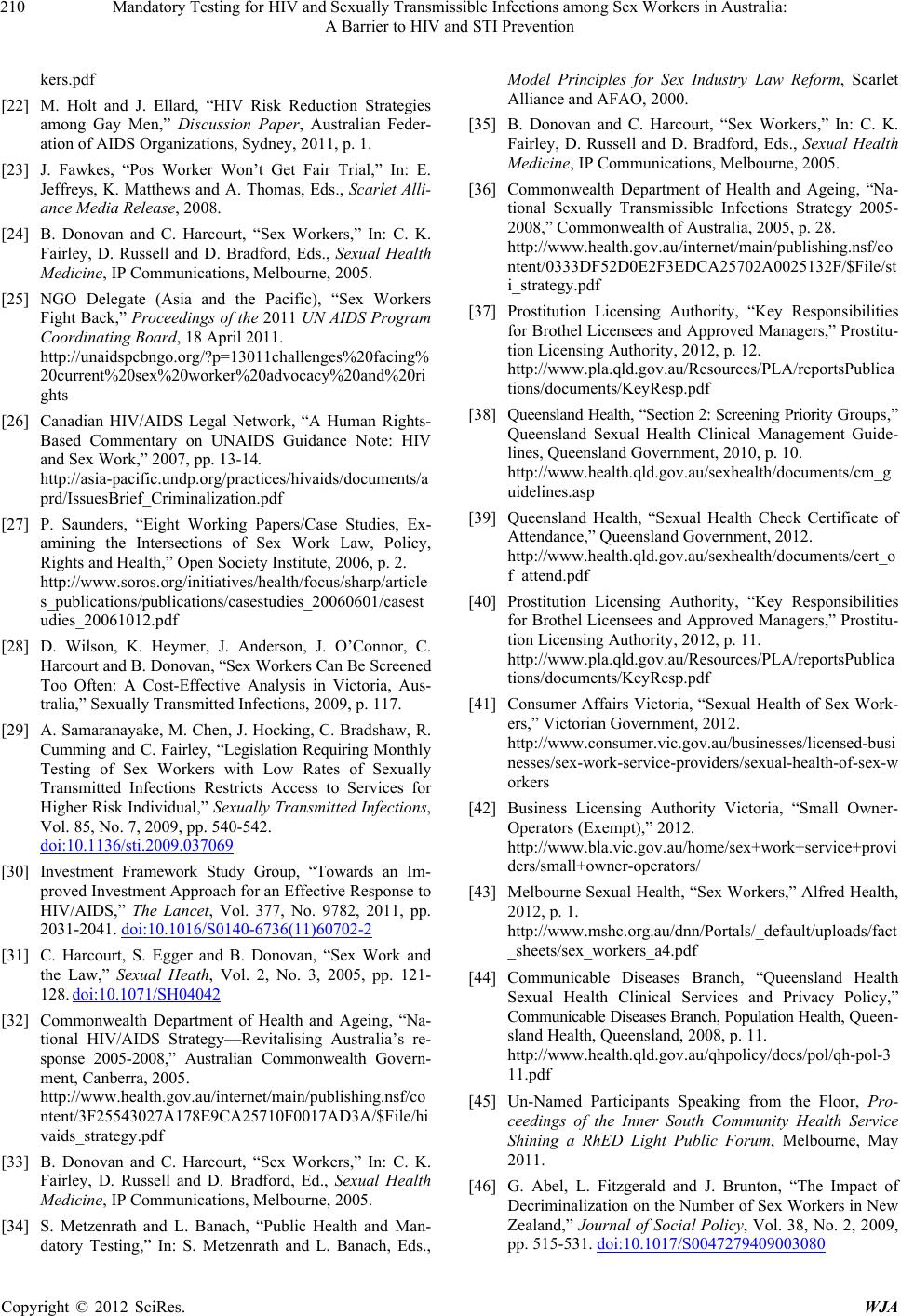 Mandatory Testing for HIV and Sexually Transmissible Infections among Sex Workers in Australia: A Barrier to HIV and STI Prevention 210 kers.pdf [22] M. Holt and J. Ellard, “HIV Risk Reduction Strategies among Gay Men,” Discussion Paper, Australian Feder- ation of AIDS Organizations, Sydney, 2011, p. 1. [23] J. Fawkes, “Pos Worker Won’t Get Fair Trial,” In: E. Jeffreys, K. Matthews and A. Thomas, Eds., Scarlet Alli- ance Media Release, 2008. [24] B. Donovan and C. Harcourt, “Sex Workers,” In: C. K. Fairley, D. Russell and D. Bradford, Eds., Sexual Health Medicine, IP Communications, Melbourne, 2005. [25] NGO Delegate (Asia and the Pacific), “Sex Workers Fight Back,” Proceedings of the 2011 UN AIDS Program Coordinating Board, 18 April 2011. http://unaidspcbngo.org/?p=13011challenges%20facing% 20current%20sex%20worker%20advocacy%20and%20ri ghts [26] Canadian HIV/AIDS Legal Network, “A Human Rights- Based Commentary on UNAIDS Guidance Note: HIV and Sex Work,” 2007, pp. 13-14. http://asia-pacific.undp.org/practices/hivaids/documents/a prd/IssuesBrief_Criminalization.pdf [27] P. Saunders, “Eight Working Papers/Case Studies, Ex- amining the Intersections of Sex Work Law, Policy, Rights and Health,” Open Society Institute, 2006, p. 2. http://www.soros.org/initiatives/health/focus/sharp/article s_publications/publications/casestudies_20060601/casest udies_20061012.pdf [28] D. Wilson, K. Heymer, J. Anderson, J. O’Connor, C. Harcourt and B. Donovan, “Sex Workers Can Be Screened Too Often: A Cost-Effective Analysis in Victoria, Aus- tralia,” Sexually Transmitted Infections, 2009, p. 117. [29] A. Samaranayake, M. Chen, J. Hocking, C. Bradshaw, R. Cumming and C. Fairley, “Legislation Requiring Monthly Testing of Sex Workers with Low Rates of Sexually Transmitted Infections Restricts Access to Services for Higher Risk Individual,” Sexually Transmitted Infections, Vol. 85, No. 7, 2009, pp. 540-542. doi:10.1136/sti.2009.037069 [30] Investment Framework Study Group, “Towards an Im- proved Investment Approach for an Effective Response to HIV/AIDS,” The Lancet, Vol. 377, No. 9782, 2011, pp. 2031-2041. doi:10.1016/S0140-6736(11)60702-2 [31] C. Harcourt, S. Egger and B. Donovan, “Sex Work and the Law,” Sexual Heath, Vol. 2, No. 3, 2005, pp. 121- 128. doi:10.1071/SH04042 [32] Commonwealth Department of Health and Ageing, “Na- tional HIV/AIDS Strategy—Revitalising Australia’s re- sponse 2005-2008,” Australian Commonwealth Govern- ment, Canberra, 2005. http://www.health.gov.au/internet/main/publishing.nsf/co ntent/3F25543027A178E9CA25710F0017AD3A/$File/hi vaids_strategy.pdf [33] B. Donovan and C. Harcourt, “Sex Workers,” In: C. K. Fairley, D. Russell and D. Bradford, Ed., Sexual Health Medicine, IP Communications, Melbourne, 2005. [34] S. Metzenrath and L. Banach, “Public Health and Man- datory Testing,” In: S. Metzenrath and L. Banach, Eds., Model Principles for Sex Industry Law Reform, Scarlet Alliance and AFAO, 2000. [35] B. Donovan and C. Harcourt, “Sex Workers,” In: C. K. Fairley, D. Russell and D. Bradford, Eds., Sexual Health Medicine, IP Communications, Melbourne, 2005. [36] Commonwealth Department of Health and Ageing, “Na- tional Sexually Transmissible Infections Strategy 2005- 2008,” Commonwealth of Australia, 2005, p. 28. http://www.health.gov.au/internet/main/publishing.nsf/co ntent/0333DF52D0E2F3EDCA25702A0025132F/$File/st i_strategy.pdf [37] Prostitution Licensing Authority, “Key Responsibilities for Brothel Licensees and Approved Managers,” Prostitu- tion Licensing Authority, 2012, p. 12. http://www.pla.qld.gov.au/Resources/PLA/reportsPublica tions/documents/KeyResp.pdf [38] Queensland Health, “Section 2: Screening Priority Groups,” Queensland Sexual Health Clinical Management Guide- lines, Queensland Government, 2010, p. 10. http://www.health.qld.gov.au/sexhealth/documents/cm_g uidelines.asp [39] Queensland Health, “Sexual Health Check Certificate of Attendance,” Queensland Government, 2012. http://www.health.qld.gov.au/sexhealth/documents/cert_o f_attend.pdf [40] Prostitution Licensing Authority, “Key Responsibilities for Brothel Licensees and Approved Managers,” Prostitu- tion Licensing Authority, 2012, p. 11. http://www.pla.qld.gov.au/Resources/PLA/reportsPublica tions/documents/KeyResp.pdf [41] Consumer Affairs Victoria, “Sexual Health of Sex Work- ers,” Victorian Government, 2012. http://www.consumer.vic.gov.au/businesses/licensed-busi nesses/sex-work-service-providers/sexual-health-of-sex-w orkers [42] Business Licensing Authority Victoria, “Small Owner- Operators (Exempt),” 2012. http://www.bla.vic.gov.au/home/sex+work+service+provi ders/small+owner-operators/ [43] Melbourne Sexual Health, “Sex Workers,” Alfred Health, 2012, p. 1. http://www.mshc.org.au/dnn/Portals/_default/uploads/fact _sheets/sex_workers_a4.pdf [44] Communicable Diseases Branch, “Queensland Health Sexual Health Clinical Services and Privacy Policy,” Communicable Diseases Branch, Population Heal th, Qu e e n- sland Health, Queensland, 2008, p. 11. http://www.health.qld.gov.au/qhpolicy / docs/pol/qh-pol-3 11.pdf [45] Un-Named Participants Speaking from the Floor, Pro- ceedings of the Inner South Community Health Service Shining a RhED Light Public Forum, Melbourne, May 2011. [46] G. Abel, L. Fitzgerald and J. Brunton, “The Impact of Decriminalization on the Number of Sex Workers in New Zealand,” Journal of Social Policy, Vol. 38, No. 2, 2009, pp. 515-531. doi:10.1017/S0047279409003080 Copyright © 2012 SciRes. WJA 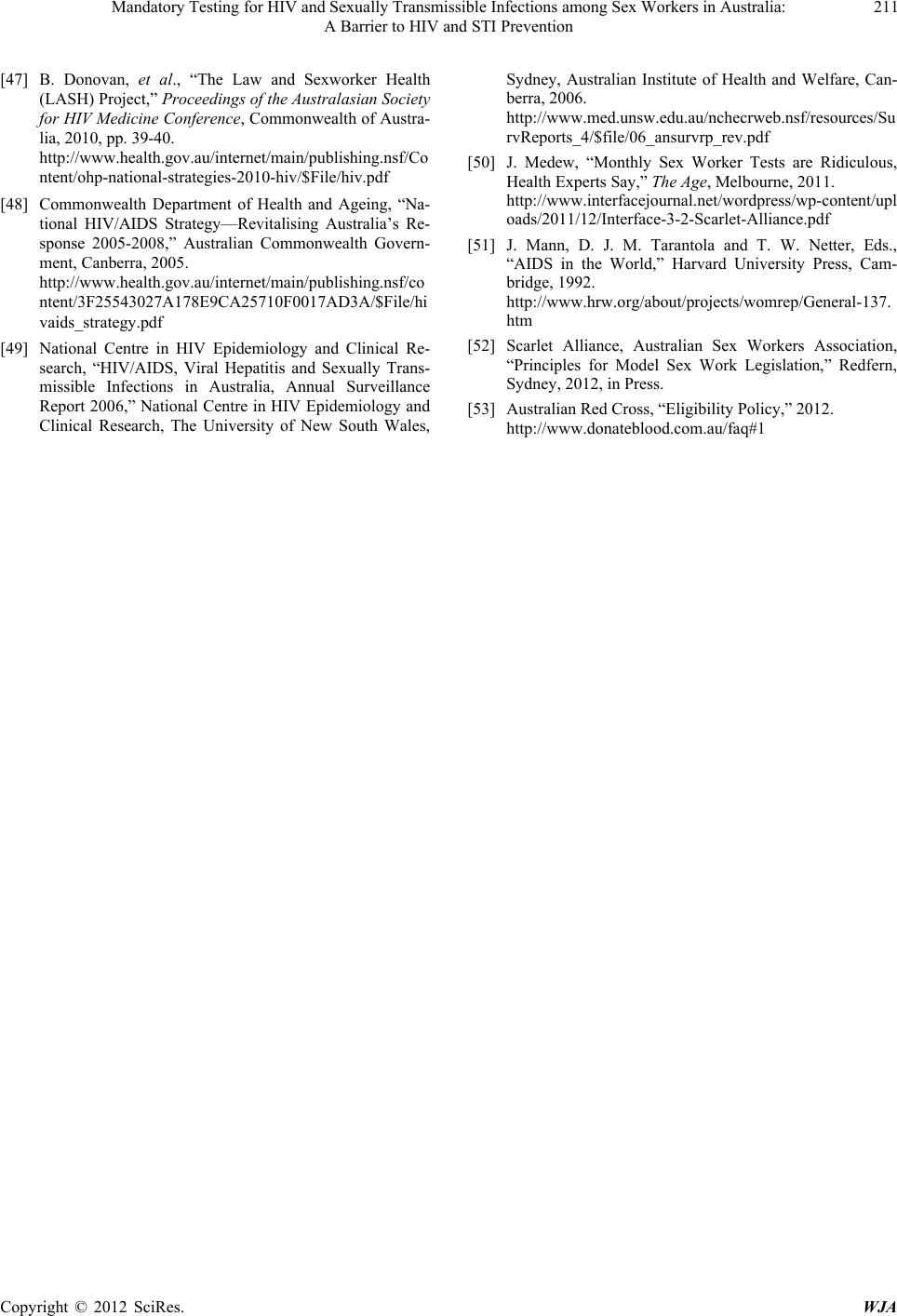 Mandatory Testing for HIV and Sexually Transmissible Infections among Sex Workers in Australia: A Barrier to HIV and STI Prevention Copyright © 2012 SciRes. WJA 211 [47] B. Donovan, et al., “The Law and Sexworker Health (LASH) Project,” Proceedings of the Australasian Society for HIV Medicine Conference, Commonwealth of Austra- lia, 2010, pp. 39-40. http://www.health.gov.au/internet/main/publishing.nsf/Co ntent/ohp-national-strategies-2010-hiv/$File/hiv.pdf [48] Commonwealth Department of Health and Ageing, “Na- tional HIV/AIDS Strategy—Revitalising Australia’s Re- sponse 2005-2008,” Australian Commonwealth Govern- ment, Canberra, 2005. http://www.health.gov.au/internet/main/publishing.nsf/co ntent/3F25543027A178E9CA25710F0017AD3A/$File/hi vaids_strategy.pdf [49] National Centre in HIV Epidemiology and Clinical Re- search, “HIV/AIDS, Viral Hepatitis and Sexually Trans- missible Infections in Australia, Annual Surveillance Report 2006,” National Centre in HIV Epidemiology and Clinical Research, The University of New South Wales, Sydney, Australian Institute of Health and Welfare, Can- berra, 2006. http://www.med.unsw.edu.au/nchecrweb.nsf/resources/Su rvReports_4/$file/06_ansurvrp_rev.pdf [50] J. Medew, “Monthly Sex Worker Tests are Ridiculous, Health Experts Say,” The Age, Melbourne, 2011. http://www.interfacejournal.net/wordpress/wp-content/upl oads/2011/12/Interface-3-2-Scarlet-Alliance.pdf [51] J. Mann, D. J. M. Tarantola and T. W. Netter, Eds., “AIDS in the World,” Harvard University Press, Cam- bridge, 1992. http://www.hrw.org/about/projects/womrep/General-137. htm [52] Scarlet Alliance, Australian Sex Workers Association, “Principles for Model Sex Work Legislation,” Redfern, Sydney, 2012, in Press. [53] Australian Red Cross, “Eligibility Policy,” 2012. http://www.donateblood.com.au/faq#1
|